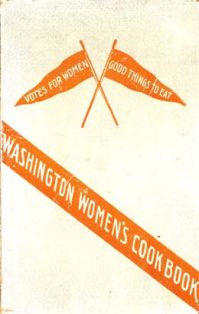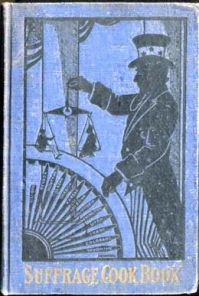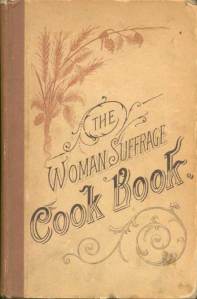In ancient Athens, the birthplace of democracy, only men were permitted to vote. Such a narrow privilege reserved only for male citizens, rightfully prompted women to fight for the existence of women’s suffrage, or the right of women to vote and to stand for electoral office. However, the global change that the suffrage movement brought about was gradual and unpromising. Various countries, colonies and states, such as New Zealand, South Australia, and Finland only granted restricted women’s suffrage in the latter half of the 19th, into the 20th century. American women won the vote on August 26, 1920 with the passage of the 19th Amendment to the Constitution. As a result, three important cook books that actively cultivated the pursuit of the right for women to vote are now considered rare commodities.
First in 1886, Bostonian Mrs. Hattie A. Burr printed her The Woman Suffrage Cook Book, Containing Thoroughly Tested and Reliable Recipes for Cooking, Directions for the Care of the Sick, and Practical Suggestions. Contributed Especially for this Work. It was meant to accompany the Festival and Bazaar in 1886. The list of contributors includes many prominent American suffragettes, such as Mary A. Livermore, Lucy Stone, Julia Ward Howe, Alice Stone Blackwell, Abbey Kelly Forster, Mrs. Oliver Ames, Portland Oregon resident Abigail Scott Duniway who was considered the mother of the suffrage movement in the Pacific Northwest, Rev. Annie H. Shaw, Francis Willard and many others. In addition to the recipes and household advice, it includes comments on women’s suffrage from Lincoln, Longfellow, Whittier, Emerson, Louisa May Alcott, Lydia Maria Child, Harriet Beecher Stowe, Clara Burton, James A, Garfield, and others.
 By the end of the 19th century, the suffrage movement was composed of a significant pool of college-educated women and women’s organizations, which made the movement a lot more respectable. In late 1908 the Washington Equal Suffrage Association published the Washington Women’s Cook Book in Seattle. The cookbook’s title page printed the legend: “Give us the vote and we will cook. The better for a wide outlook,” and the dedication: “To the first woman who realized that half of the human race were not getting a square deal, and who had the courage to voice a protest.” Linda Deziah Jennings of LaConner edited the volume, with assistance from Washington Equal Suffrage Association president Emma Smith Devoe.
By the end of the 19th century, the suffrage movement was composed of a significant pool of college-educated women and women’s organizations, which made the movement a lot more respectable. In late 1908 the Washington Equal Suffrage Association published the Washington Women’s Cook Book in Seattle. The cookbook’s title page printed the legend: “Give us the vote and we will cook. The better for a wide outlook,” and the dedication: “To the first woman who realized that half of the human race were not getting a square deal, and who had the courage to voice a protest.” Linda Deziah Jennings of LaConner edited the volume, with assistance from Washington Equal Suffrage Association president Emma Smith Devoe.
By the 1910’s in America, women’s suffrage had become a mass movement. A parallel and much more radical movement was being carried out in Britain, where suffragettes were arrested for public disorder and given prison sentences of anywhere from 3 days to several months. In 1915, the Equal Franchise Federation of Western Pennsylvania published The Suffrage Cook Book. The book was dedicated to Fanny Garrison Villard, widow of Henry Villard and a longtime suffragist. Recipe contributions for the cook book came from Anna Howard Shaw, Laura Kleber, Charlotte Perkins Gilman, and Harriet Taylor Upton.
These three cook books spanning over 30 years of suffragists activities, cultivated the basic idea that women should have the right to vote and it should not be viewed as a distraction to domestic duties; an important milestone of social history. Moreover, the suffragist movement cookbooks can be likened to a Trojan horse in the form of a book filled with sweet offerings to the taste buds with a message to bring about social change.
 For the rare book collector of social history the lesson learned is priceless – a good opportunity comes with every social political movement of significant importance. Whether being the labor movement and socialist movement of the late 19th century, a civil rights movement, or even the women’s rights and the more recent gay rights movement, one thing for sure, is that some of the books associated with such movements will be the scarce pulse of the time. These three books are all extremely rare with mostly non first editions available for sale. When a first edition trades hands, it proves to be quite an expensive cook book selling for more than a few thousand dollars- a small price to pay for an artifact that laid groundwork for future women to live a life of independence and public activity.
For the rare book collector of social history the lesson learned is priceless – a good opportunity comes with every social political movement of significant importance. Whether being the labor movement and socialist movement of the late 19th century, a civil rights movement, or even the women’s rights and the more recent gay rights movement, one thing for sure, is that some of the books associated with such movements will be the scarce pulse of the time. These three books are all extremely rare with mostly non first editions available for sale. When a first edition trades hands, it proves to be quite an expensive cook book selling for more than a few thousand dollars- a small price to pay for an artifact that laid groundwork for future women to live a life of independence and public activity.

{ 2 comments… read them below or add one }
Is the picture of the suffrage cookbook by Kleber a first edition? I recently found a copy that appears to be a first edition but is in rather poor condition. However Uncle Sam is in gold not black ( the same color as the books title on the cover)
It’s interesting to read on the early petomorrs of voting rights for women. It wasn’t the Easterners. It was Western men who were most strongly for equal political and voting rights for women, and far earlier than in the East, as I recall into the 1860s. Wyoming is one state which led the way. The governor, and other leaders, of Wyoming made trips back to New York and other areas advocating rights for women. At one such event the governor of Wyoming countered one argument against women voting by saying that Western men were secure enough in their manhood to not be threatened by women’s rights. The first women state governors: Texas and Wyoming.
{ 1 trackback }